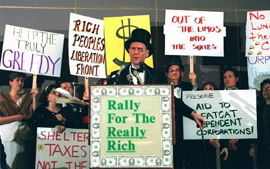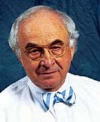

Actors in 1995 thanking Congress for all the tax breaks and financial goodies they have provided to rich people. (AP photo)
 |
There's a class war, all right. Guess who's winning.
COMMENTARY | July 192, 2012
Noted journalist Phil Meyer calls on reporters to follow the example of Barlett and Steele and see the patterns, the underlying structures that created and are perpetuating so much inequality.
By Philip Meyer
pmeyer@email.unc.edu
“Class warfare,” expressed as an epithet, keeps coming up in the election campaign as though it were something novel and dangerous. In reality, it is older than the republic.
And for the past four decades, the upper class has been getting the upper hand. Has anybody noticed?
Two Pulitzer Prize winning reporters did, and they put a spotlight on the class war two decades ago with a series in the Philadelphia Inquirer. In 1992, Donald L. Barlett and James B. Steele compiled their reports into a best-selling book, America: What Went Wrong.
But their alarm went mostly unheeded, and today’s divide between the powerful and the rest of us is greater than ever. And here’s the thing: the gap continues to widen no matter which party we vote into office.
The purpose of democracy, in the eyes of our founders, was to maintain fairness in the inevitable class struggle. In designing our Constitution, they borrowed from both English and French traditions of limited and divided government to keep power in check. And they counted on the free flow of information to help.
Today, the problem is too much information. The digital age has increased the flow of facts, but they are too little understood and analyzed. A hunter-gatherer-kind of journalism is no longer enough. We are distracted from seeing the patterns made by the events, and we don’t notice the underlying structures that created the patterns.
Using paper trails to find patterns and shine a light on their causes is Barlett and Steele’s specialty. Now they have updated their previous work. Some of it has appeared in the Philadelphia Inquirer, and they have received help from the Investigative Reporting Workshop of American University. (I am a former member of the Workshop’s advisory board.)
Their report is to be published by Public Affairs as “The Betrayal of the American Dream.” It revisits some of the same people whose situations gave the problem a human face in 1992. You can preview it by browsing the Workshop’s website.
The winners would like us to believe that the growing disparities are the result of uncontrollable forces in the world economy. Barlett and Steele have convincing evidence that they’re not. The gap is the result of deliberate efforts by both Republicans and Democrats to please the groups that finance their election campaigns.
Some examples:
- Tax policies over the decades have steadily shifted the burden from corporations and wealthy individuals to the middle class.
- Claiming support for free trade, our government encourages corporations to send jobs overseas and then bring the foreign-made products back with few or no tariff barriers. But free trade isn’t really free because the countries we buy from continue to place restrictions on our ability to sell to their people. This arrangement is good for corporate executives and shareholders, bad for American consumers and workers.
- Private pensions are shrinking or disappearing – except, of course, for those awarded to corporate executives.
- Costs of higher education are being passed increasingly to students who take on crippling debt to pay – and with fewer prospects than in the past of being able to find the good jobs that would make it worthwhile.
- Deregulation has taken important protection away from both workers and consumers, particularly in the fields of air travel, trucking, and finance. Barlett and Steele remind us that it was Jimmy Carter, a Democrat, who got that ball rolling with deregulation of aviation and trucking.
- The roads and bridges and dams that make up our national infrastructure, much of it built during the Great Depression in the 1930s, are falling apart. Rebuilding it would create jobs, but that’s not happening.
On that last item, the infrastructure, mostly it's not happening but some of it is being rebuilt. The Bay Bridge between San Francisco and Oakland was badly damaged in an earthquake. Arnold Schwarzenegger was governor of California at the time, and he went to the factory where the new bridge components were being made so that he could thank the workers personally. The factory was in China.
Bernard Bailyn, the Harvard historian, analyzed the founders’ view of power in his 1967 book “The Ideological Origins of the American Revolution.” They believed, he said, that “power, always and everywhere, had a pernicious, corrupting effect upon men.”
Pre-revolutionary political thought saw power as aggressive and expansive. The colonists believed that the desire for it was behind every political issue. That insight, said Bailyn, “serves to link the Revolutionary generation to our own in the most intimate way.”
We ought to pay attention.
|
|
Philip Meyer, a 1966-'67 Nieman Fellow, recently retired as the holder of the Knight chair of Journalism at the University of North Carolina. His most recent book is "Paper Route: Finding My Way to Precision Journalism." 
E-mail: pmeyer@email.unc.edu
|
|
|
|
|





